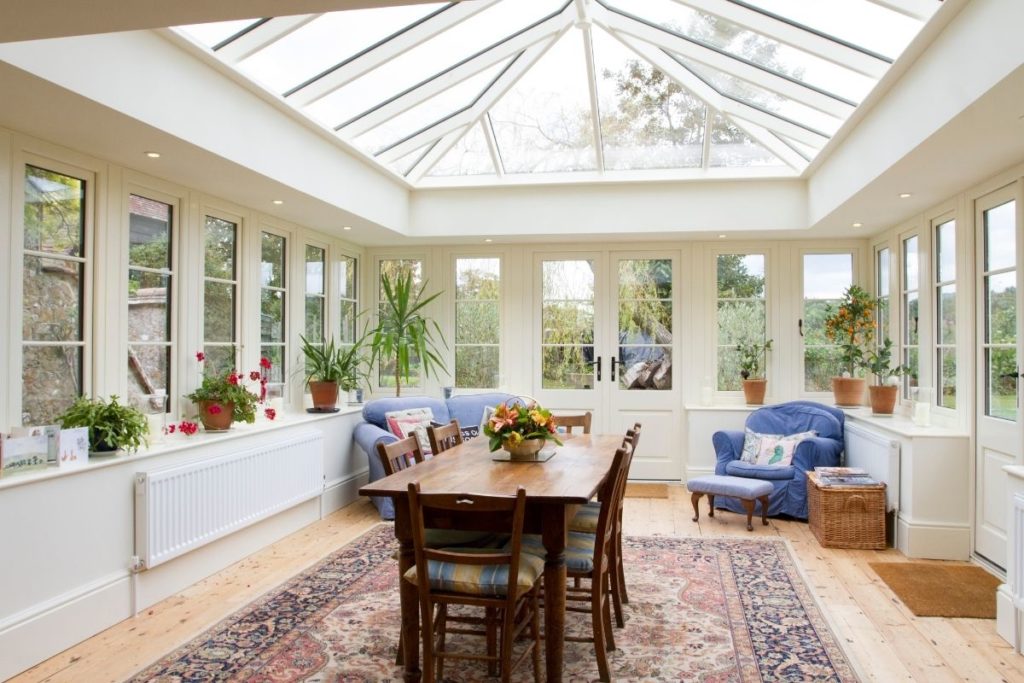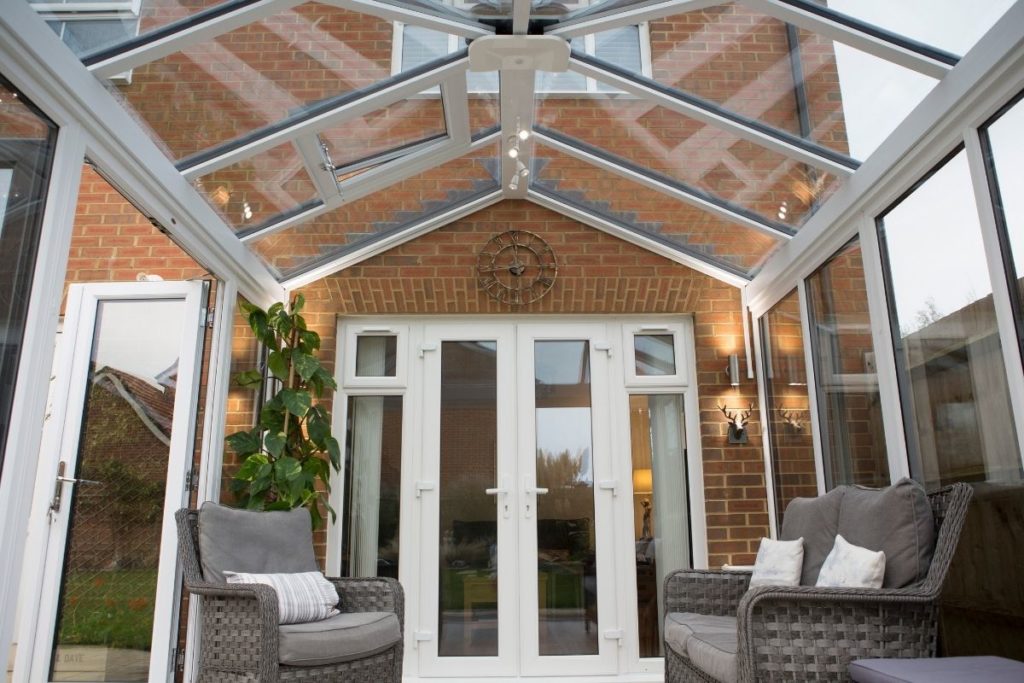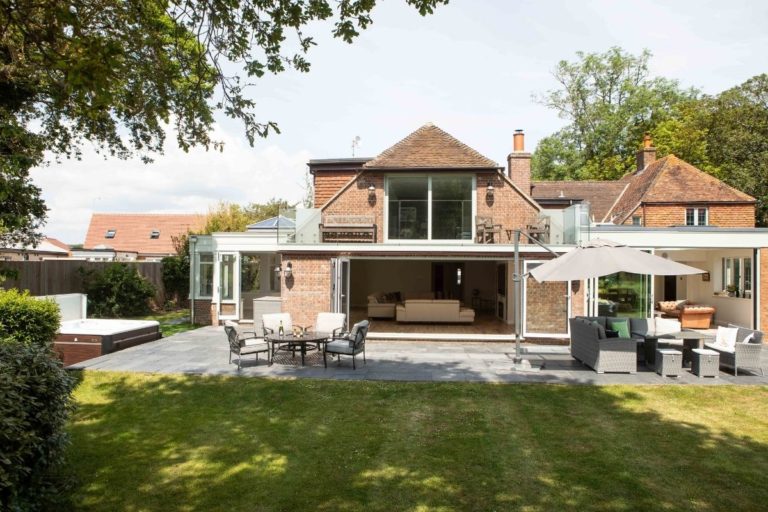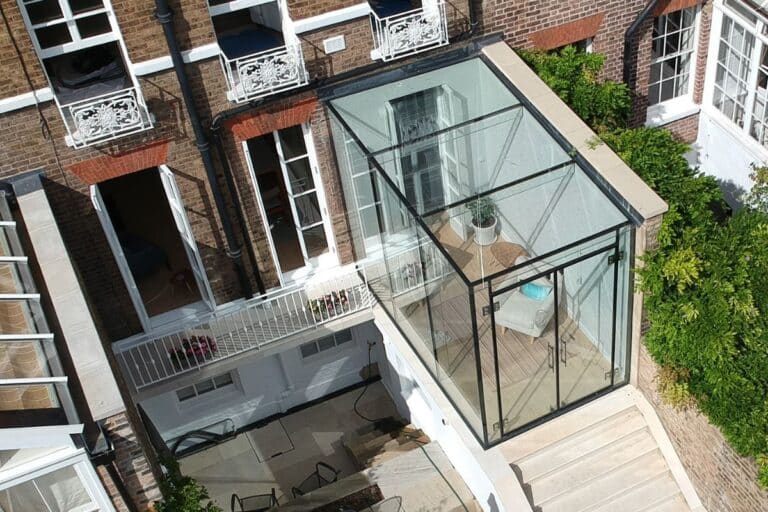Orangeries and conservatories are popular home extension options that offer truly versatile designs and layouts. Whether you prefer a modern, contemporary, or traditional look, the glass room can be designed in a way to suit your desires and blend in seamlessly with your home. ‘Orangery’ and ‘conservatory’ are often used interchangeably to describe a predominantly glass structure, but there are differences that set them apart. Here is a quick guide to the features that make a glass room a conservatory or an orangery.
GLASS EXTENSION OPTIONS
What is the difference between an orangery and a conservatory?
The main difference between an orangey and a conservatory is the roof. An orangery traditionally has a flat solid roof with a glass lantern in the centre. A conservatory has at least 75% of the structure covered with a glass roof, but more usually the entire roof is made of glass.

What is an orangery?
Orangeries feel closer to the design of a traditional extension, they tend to incorporate less glass than a conservatory and use a solid brick structure as the foundation to support large windows and doors. Your orangery design can incorporate both full-height walls as well as dwarf walls and the material used can be matched to blend in with the existing building creating a seamless aesthetic. An orangery will also include window and door frames that can be crafted from hardwood, aluminium, or uPVC as well as beautiful solid British oak. The key feature of an orangery that makes it distinguishable from a conservatory is its lantern roof. Orangeries are designed with a flat roof, with pelmets that run around the edge of the glass lantern. The lantern roof is the real selling feature of an orangery, they just look spectacular and let in lots of natural light. There are many design and finish options, so you can get the look and feel that is in keeping with your home and vision. There is often more construction involved in building an orangery, but it will result in a structure that feels integral to the aesthetic of your home.
Attached or an independent space?
An orangery can be built attached to your home to increase your living space, such as extending your kitchen and dining area. Opening the external wall of your home up to your orangery space is a great option to make the new structure feel even more integral. You will need building regulation sign-off to achieve this and it is likely there will be some structural work required to sure up your home. As another option, you could add in wide double doors or even full-width bi-fold doors between your home and the orangery room. This will enable you to choose when you want to keep the rooms separated or open the doors up to allow free flow between the two spaces, giving you the best of both worlds. Or your orangery can even be built as a standalone structure within your garden to be used as a home office, summer house or perhaps guest accommodation. Again, the addition of French doors or bi-fold doors helps to connect your standalone space with your garden whether taking in the view from the warmth of your new room, or with the doors open wide in the summer months. Standalone or attached to your home, you can often get your orangery built under permitted development rights, as long as you haven’t already extended your home or you don’t live in a listed property or in a conservation area.

What is a conservatory?
A favourite for homeowners across the UK for many years, the conservatory is a brilliant option if you are looking to add an extra room in a shorter time frame and with minimal building work. The conservatory has a much higher glass-to-wall and frame ratio than the orangery and has a full glass roof at the centre of the design. The amount of glass used in a conservatory room is usually the main feature that may draw a customer to choose it over an orangery, but it really depends on what you want to achieve and your style. You can choose a combination of full glass sides with half-height glass windows, patio doors and solid walls. Usually, within conservatory design, any solid walls are the external walls of the house that you are extending. Still, there are instances where you may choose to add an additional full-height wall, perhaps to the side if your new room is positioned right next to your boundary fence. You can also incorporate dwarf walls to support your choice of frames and windows, which like with the orangery can be matched to your home style. Conservatory frames can be built in a choice of materials from low maintenance uPVC as well as timber and aluminium, the same as an orangery extension. You can choose from a variety of finishes and colours in all 3 frame choices, whether that be white uPVC or a calming shade of sage green for your painted timber frames.
Conservatories are perfect to create an extra light-filled room to dine in or relax and enjoy your garden while in the comfort of being indoors. The introduction of temperature-controlled glass, which keeps your glass extension at a more constant and comfortable temperature, has made the conservatory extension an excellent extension option that can withstand the changeable British weather. Like with an orangery, generally planning permission is not required for a conservatory if you stick within the sizing guidelines stated within permitted development, but it’s always best to check with the experts first.
Your orangery or conservatory project
For more inspiration and to help you decide whether an orangery or conservatory is right for you, take a look at our past customer projects in our gallery. If you would like to discuss your project and get tailored advice as well as an idea of costs, a member of the team will be happy to help, get in touch below.



